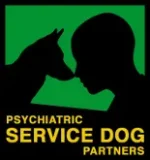Within the Service Dog community, I am seeing more and more people that get confused about the differences between the black-and-white laws and what most handlers see as the correct training and behaviors of our service dogs.
Laws & Regulations
Here in the United States, there are several federal agencies that set up the core guidelines for assistance animals.
Federal
Department of Justice through the American Disability Act (ADA) sets the core requirements.
The ADA and FHA are the most known, but there are others Like the EEOC, FDA, and others that do have regulations for service dogs.
States and Local
Most, if not all, states have their own laws governing service dogs. The best example of this is how service dogs in training (SDiT) are handled as SDiT's are not covered by federal governance. Also, as local law enforcement agencies cannot enforce federal laws states typically have their own laws covering service animals especially when it comes to the public access service animals need for their handlers.
For the handler, it is very important to know the laws within the state you have the dog in. In my experience, most law enforcement does not know their service dog statutes as they have so few encounters with service dog teams.
Ethics
Definition of Ethics: moral principles that govern a person's behavior or the conducting of an activity.
It is very important to remember that one person's ethics may not be another person's ethics. This tends to create a lot of discord within the service dog communities. Opinions, right? Here is a list of the most common when it comes to having a service dog:
Doctors' recommendation: While the ADA has no requirement for this it can be important for the handler to have. If the handler must submit any type of request for reasonable accommodations, they will need a letter from their medical provider. If the team is issued a summons for court that note can save a lot of time.
Highly socialized: This is one of the most misunderstood terms in the SD community. Many handlers seem to think that socialization training is only training the dog to be near other animals and humans. Socialization includes everything from common environmental sounds, statues, and anything your dog may encounter that it is not used to. Socialization is lifelong training.
Organizations
There are several organizations that help by developing their own guidelines on the training of service dogs. Assistance Dog International (ADI) and International Association of Assistance Dog Partners (IAADP) are 2 of the most recognized and their standards are considered top-notch.
Personally, as a self-trainer, I used IAADP standards as they gave me a good blueprint for how to train my dog, and it requires so much more than the base ADA requirements.
So, which one is more important? I think they are all equally important but it is also important to remember that simply because I see them as pretty much equal does not mean that someone else does. The laws are the primary foundation for our team and sadly the rest is up to the handler and/or trainer.
If you see a dog with a service dog vest on pulling hard at the lead does that mean it is not a service animal? The handler is in control some would say. Or might it be that the dog is just having a bad day?
It is up to us, the handlers, to put forth our best efforts and be able to show off our dogs as they work for us. And most importantly be nice.
Laws & Regulations
Here in the United States, there are several federal agencies that set up the core guidelines for assistance animals.
Federal
Department of Justice through the American Disability Act (ADA) sets the core requirements.
- The handler must fit within the ADA definition of being disabled.
- The dog must be tasked and trained to mitigate one or more disabilities for the handler.
- The animal must always be under the control of the handler.
- The animal must be housebroken.
The ADA and FHA are the most known, but there are others Like the EEOC, FDA, and others that do have regulations for service dogs.
States and Local
Most, if not all, states have their own laws governing service dogs. The best example of this is how service dogs in training (SDiT) are handled as SDiT's are not covered by federal governance. Also, as local law enforcement agencies cannot enforce federal laws states typically have their own laws covering service animals especially when it comes to the public access service animals need for their handlers.
For the handler, it is very important to know the laws within the state you have the dog in. In my experience, most law enforcement does not know their service dog statutes as they have so few encounters with service dog teams.
Ethics
Definition of Ethics: moral principles that govern a person's behavior or the conducting of an activity.
It is very important to remember that one person's ethics may not be another person's ethics. This tends to create a lot of discord within the service dog communities. Opinions, right? Here is a list of the most common when it comes to having a service dog:
Doctors' recommendation: While the ADA has no requirement for this it can be important for the handler to have. If the handler must submit any type of request for reasonable accommodations, they will need a letter from their medical provider. If the team is issued a summons for court that note can save a lot of time.
Highly socialized: This is one of the most misunderstood terms in the SD community. Many handlers seem to think that socialization training is only training the dog to be near other animals and humans. Socialization includes everything from common environmental sounds, statues, and anything your dog may encounter that it is not used to. Socialization is lifelong training.
- Highly trained dog: While the ADA only stipulates task training and being housebroken as required training is that all we should do?
- Basic Obedience: Personally, I think every dog should have this. Simply put, it is a great base to teach your dog where you can train more specific actions.
- Advanced Obedience: Normally I group skills like distance recall, down (while in motion), and most of the trained tasks in this area. This normally is for tasks I need and the dog's safety.
- Public Access Training (PAT): One of the most ignored skill sets. Most of these skills are based on the sets above but this focuses on the dog's actions while in public access areas. Things like stopping at crosswalks, and waiting in the vehicle until called.
- Grooming: Yes, this makes it to my list! As a handler, we should make sure we present as positive an image as possible. Most importantly this tends to limit public access problems when we are out and about, also it should be a pride thing for all of us
Organizations
There are several organizations that help by developing their own guidelines on the training of service dogs. Assistance Dog International (ADI) and International Association of Assistance Dog Partners (IAADP) are 2 of the most recognized and their standards are considered top-notch.
Personally, as a self-trainer, I used IAADP standards as they gave me a good blueprint for how to train my dog, and it requires so much more than the base ADA requirements.
So, which one is more important? I think they are all equally important but it is also important to remember that simply because I see them as pretty much equal does not mean that someone else does. The laws are the primary foundation for our team and sadly the rest is up to the handler and/or trainer.
If you see a dog with a service dog vest on pulling hard at the lead does that mean it is not a service animal? The handler is in control some would say. Or might it be that the dog is just having a bad day?
It is up to us, the handlers, to put forth our best efforts and be able to show off our dogs as they work for us. And most importantly be nice.

















